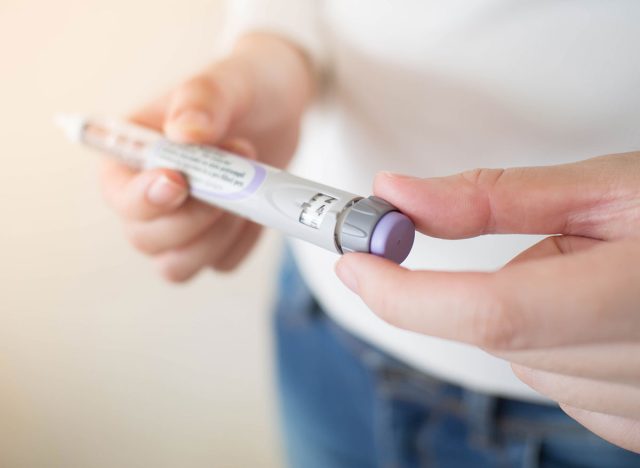More than 34 million Americans are living with diabetes–a disease that happens when your blood sugar is too high. If left untreated, “Diabetes that isn’t managed can be detrimental to your health in the long-term,” Dr. Yossi Bahagon, MD. M.B.I, co-founder of Sweetch tells Eat This, Not That! Health. He adds, “If not treated, and blood sugar levels aren’t controlled, having high blood sugar levels can cause other serious health problems like heart disease, vision loss, and kidney disease. Other than physiological effects, diabetes can also have a negative impact on mental health due to the stress and anxiety that comes along with managing the disease.” Dr. Bahagon explains to Eat This, Not That! Health what the main causes of diabetes are and how to effectively treat the disease. Read on—and to ensure your health and the health of others, don’t miss these Sure Signs You’ve Already Had COVID.


Dr. Bahagon says, “In an individual without diabetes, glucose (a sugar) is usually absorbed in the bloodstream and enters the cells with the help of insulin. Insulin acts like a key that lets the blood sugar into your cells to be used for energy. This hormone is produced and secreted by the pancreas and is made in higher amounts when your blood glucose levels rise. When your blood glucose levels are low (for example if you haven’t eaten in a while), your liver will break down stored glycogen into glucose so that your blood glucose levels stay in a normal range. Type 2 diabetes is caused by your cells becoming resistant, or less sensitive to insulin, and your pancreas cannot make enough insulin to overcome this resistance. This results in the sugar building up in your bloodstream, instead of moving into your cells for energy. While there isn’t a clear cause to “why” this happens, there are certain factors that are strongly linked to developing prediabetes, and eventually type 2 diabetes. These include – a higher weight or BMI, physical inactivity, high blood pressure, high cholesterol and triglycerides, age, a history of gestational diabetes or polycystic ovarian syndrome, family history and race or ethnicity.”


According to Dr. Bahagon, “A high BMI can increase the chance of developing diabetes as having more fatty tissue can make your cells more resistant to insulin. Independent of weight, physical inactivity can also cause muscle cells to be less sensitive to insulin and therefore result in higher blood glucose levels. Your risk for diabetes also increases as you age. This might be from doing less exercise and losing more muscle mass while gaining weight. Finally, high cholesterol and triglyceride levels can increase insulin resistance and diabetes risk and can also be a complication of having type 2 diabetes.”


“When it comes to Type 2 diabetes the risk factors can be divided into two different categories – genetic or factors that are out of an individual’s control, and environmental,” says Dr. Bahagon. “On the one end, a family history of diabetes (such as parents, siblings, grandparents), certain races or ethnic backgrounds such as Hispanic, Asian American, American Indian and African American, a history of polycystic ovarian syndrome or gestational diabetes, in addition to age are all factors that we can’t change but increase the risk of diabetes. On the other end, areas that individuals can have an impact on include weight, physical inactivity, high blood pressure and abnormal cholesterol or triglyceride levels. This is where the importance of educating people about the risks that they have control of is extremely important.”


Dr. Bahagon explains, “Depending on how much the diabetes has progressed, there will be different ways to treat the individual. In all cases, making lifestyle changes is an essential part of diabetes management. This includes dietary changes such as including more fruits and vegetables, foods that are high in dietary fiber, reducing refined carbohydrates and adding more healthy fats and proteins to meals. In many cases, having an understanding of carbohydrate portions at every meal will also help people in reducing blood sugar spikes after eating.”


Dr. Bahagon says, “Regular physical activity also plays a big role in managing blood sugar levels. Aiming for at least 150 minutes a week of exercise spread out over at least 3 days, without having more than 2 days in between, such as walking or biking can lower blood sugar levels by helping move the sugar into your cells where it’s used for energy. Additionally, exercise can increase your insulin sensitivity so that your body needs less insulin to move the sugar into your cells. Other lifestyle and behavior changes also include managing stress and making sure to get enough sleep – these can both have an impact on your blood sugar levels.”


Dr. Bahagon explains, “Other than lifestyle changes, many people with type 2 diabetes will also need to take some form of oral or injected medication that all work in different ways to essentially help your body move the sugar from your blood to your cells. In some cases, people will need to take insulin to lower blood sugar levels.”


“Monitoring blood sugar levels is also an important part of treating diabetes,” says Dr. Bahagon. “For people taking insulin, they may need to track this more often, while those taking medication or managing diabetes with diet and exercise might only check their glucose levels once a day, or every 6 months.”
RELATED: Proven Ways to Lose Visceral Fat Fast, Say Experts


Dr. Bahagon states, “While type 1 diabetes can’t be prevented, type 2, prediabetes and gestational diabetes can be prevented by the same healthy lifestyle changes that help treat them. Focusing on including healthy foods like fruits, vegetables, legumes, whole grains, and less added sugars, saturated fat and trans-fat, as well as being mindful of portion sizes and having balanced meals all play a role in diabetes prevention. Similarly, increasing physical activity levels can also help prevent diabetes. As with diabetes treatment, achieving 150-300 minutes of moderate aerobic exercise (such as walking, or swimming) is enough to make a difference, as well as muscle-strengthening activity like lifting weights, at least two days each week.”
RELATED: If You Do This in the Morning, Get Checked for Dementia


Dr. Bahagon reminds us that, “Weight management or achieving a healthy weight is another important element for diabetes prevention. For people that are overweight, losing 7% of your total body weight is enough to reduce the risk.”
RELATED: “Bags Under Eye” Busting Secrets That Really Work


According to Dr. Bahagon, “Education and awareness of the risk factors and prevention measures is essential to diabetes prevention. Making sure that people understand if they are at risk, and what to do about it, including making lifestyle changes and getting regular blood tests will have a big impact in diabetes prevention. Luckily, certain Digital Therapeutics (DTX) mobile apps, especially ones aimed at engaging people at risk for, or already managing diabetes, can provide support and guidance and have been clinically validated to achieve the long-lasting behavior change required, and improve health outcomes.”